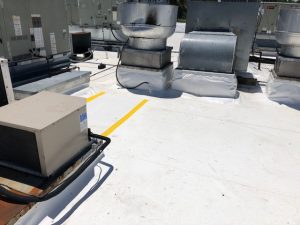From sweltering heat waves to torrential downpours, extreme weather conditions can have a significant impact on commercial roofs. This post will delve into the effects of changing weather patterns on different types of commercial roofing materials and provide helpful tips for maintaining your roof amid these challenges.

The Role of Materials in Commercial Roofing
When it comes to commercial roofs, several materials are commonly used, each with unique properties that react differently to various weather conditions:
- Built-up Roofing (BUR): Known for its durability, BUR consists of alternating layers of bitumen and reinforcing fabrics. While it’s resistant to water damage, extreme heat can cause the layers to expand, leading to potential cracking or blistering.
- EPDM Roofing: EPDM (ethylene propylene diene monomer) is a rubber-based material known for its resistance to UV radiation and extreme temperatures. However, heavy rain and hail can cause punctures or tears in the material.
- TPO and PVC Roofing: These single-ply roofing systems are popular for their heat-reflective and energy-efficient properties. Yet, they can be susceptible to wind uplift and punctures from debris during storms.
- Metal Roofing: Metal roofs are durable and fire-resistant, but they can dent during hailstorms. Also, fluctuations between hot and cold temperatures can cause the metal to expand and contract, leading to potential leaks.
The Impact of Extreme Weather Conditions
- Heavy Rain and Snow: Prolonged periods of rain or heavy snowfall can lead to water pooling on the roof, especially in flat roofing systems. This can cause leaks or structural damage if the weight of the snow exceeds the roof’s load-bearing capacity.
- Intense Heat: High temperatures can cause roofing materials to expand, potentially leading to cracks or warping. UV radiation can also degrade certain materials over time, reducing their lifespan.
- Strong Winds: High winds can lead to wind uplift, potentially ripping off roofing materials or causing debris to puncture the roof.
Mitigating Weather Damage: Maintenance Tips
- Regular Inspections: Schedule professional inspections at least twice a year and after major weather events to catch any potential issues early.
- Proper Drainage: Ensure your roof has an effective drainage system to prevent water accumulation.
- Prompt Repairs: If damage is detected, arrange for repairs promptly to prevent further deterioration.
While we can’t control the weather, understanding its impact on different roofing materials can help us make informed decisions about our commercial roofing systems. Regular maintenance and inspections are also key to mitigating potential weather damage and ensuring the longevity of your commercial roof.
About Bel Air Foam & Roofing, Inc.
Bel Air Foam & Roofing is a Maryland commercial roofing company with an experienced team of commercial roof contractors. We provide commercial roofing services, such as commercial roof replacement, flat roof installation, and commercial roof repair in Maryland, Virginia, Pennsylvania, and Delaware.
